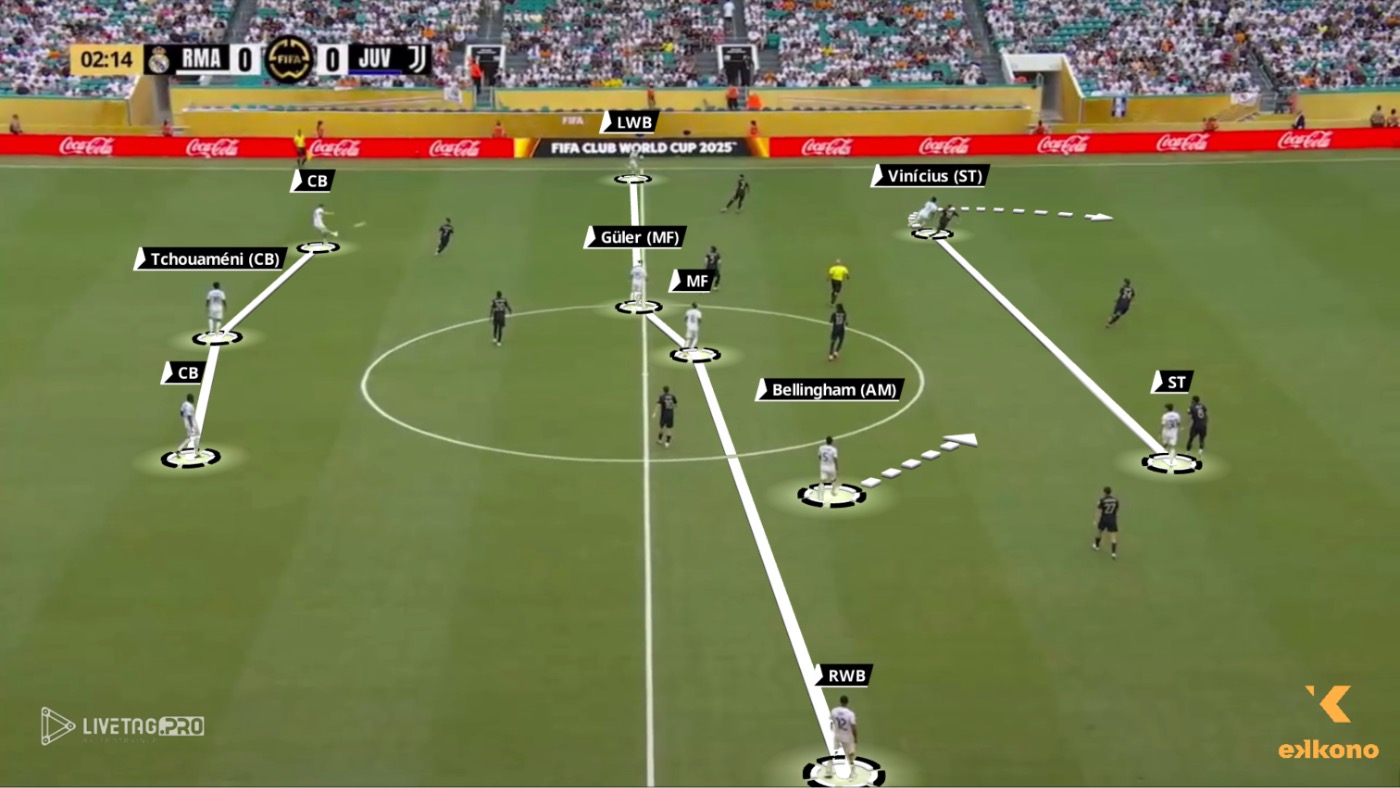
Introduction
During his first matches at the Club World Cup, Xabi Alonso introduced a new tactical identity at Real Madrid, deploying a base 3-4-1-2 system. This structure is not just a positional arrangement, but rather a functional and adaptable framework that allows the team to control central spaces, manipulate the opponent through possession, and create threats both inside and out. It represents a clear attempt to maximize the individual qualities of his key players while maintaining collective balance. Of course, though, as we could see during the tournament, the Basque coach has still some challenges to figure out such as creating the best environment for Vinicius Jr. and Mbappé to shine.
Base Structure: 3-4-1-2 with Functional Adaptability
Arda Güler as Deep-Lying Playmaker
One of the most notable innovations is the role of Arda Güler as a deep-lying playmaker. Positioned as the more associative central midfielder alongside Valverde or Tchouaméni in a double pivot, Güler’s presence provides structure and creativity in the first and second phases of build-up. He frequently drops to the base to offer passing lanes to the center-backs, especially the more technically gifted one, and orchestrates the rhythm of play without rushing. His short combinations with wingbacks and advanced midfielders create wall passes and fixations that help Madrid progress through compact areas. Structurally, his positioning frees Valverde to break lines or attack spaces, and he ensures the team retains superiority during build-up when the wingbacks are positioned high and wide.
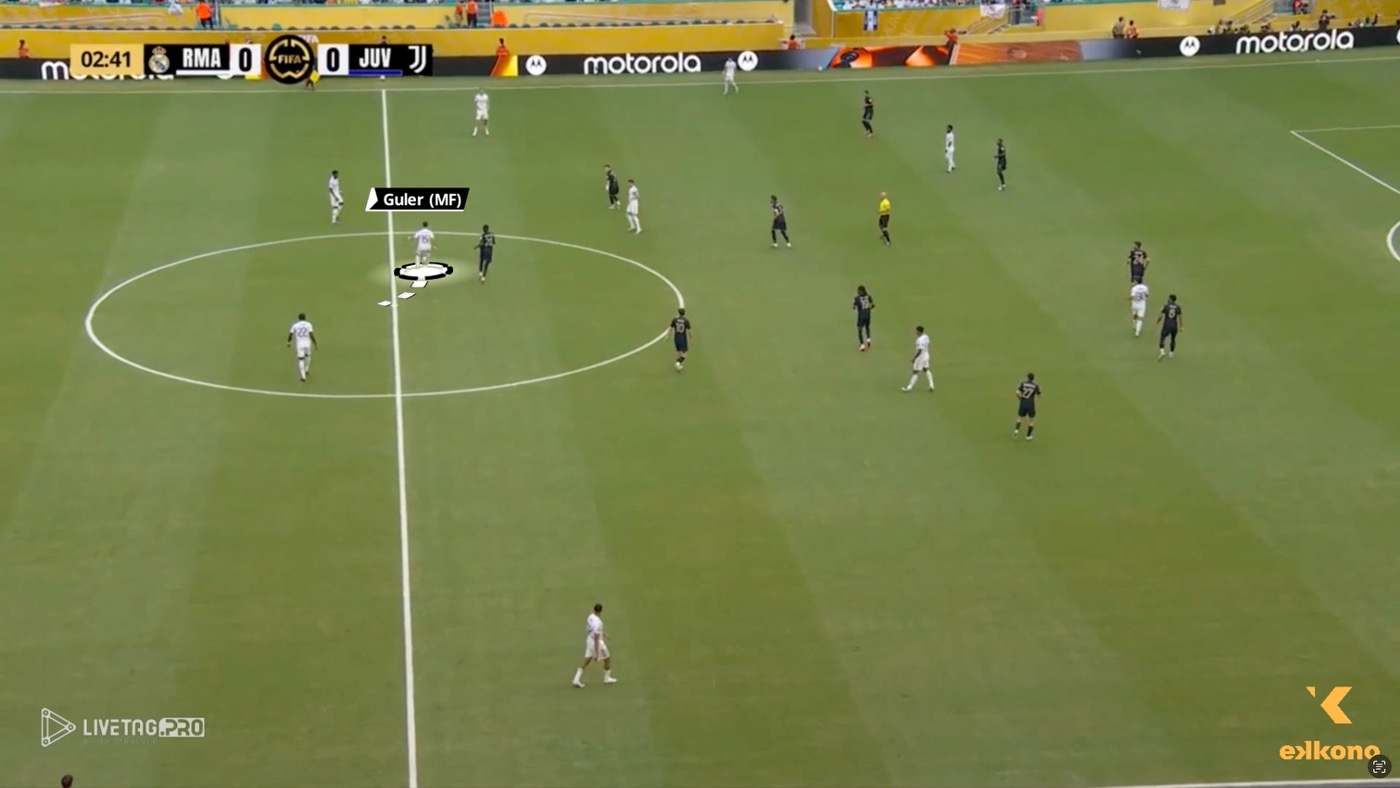
Arda Güler as Deep-Lying Playmaker
Arda Güler (MF) has taken on a more active role as a deep-lying playmaker, helping the team progress during the build-up and allowing Fede Valverde to push higher up the pitch.
Tchouaméni as Structural Base and Third Center Back
Tchouaméni complements this dynamic by anchoring the team structurally, often dropping between the center-backs or shifting into the right central defender role to form a situational 3-2 or 3-1 structure during the build-up. This adjustment secures clean progression under pressure, pins back the opponent’s first pressing line, and provides more freedom to Fran García on the left to push higher and wider. His ability to adjust timing, depth, and body orientation provides both progression and stability in case of turnovers, making him a key player for the team’s balance.
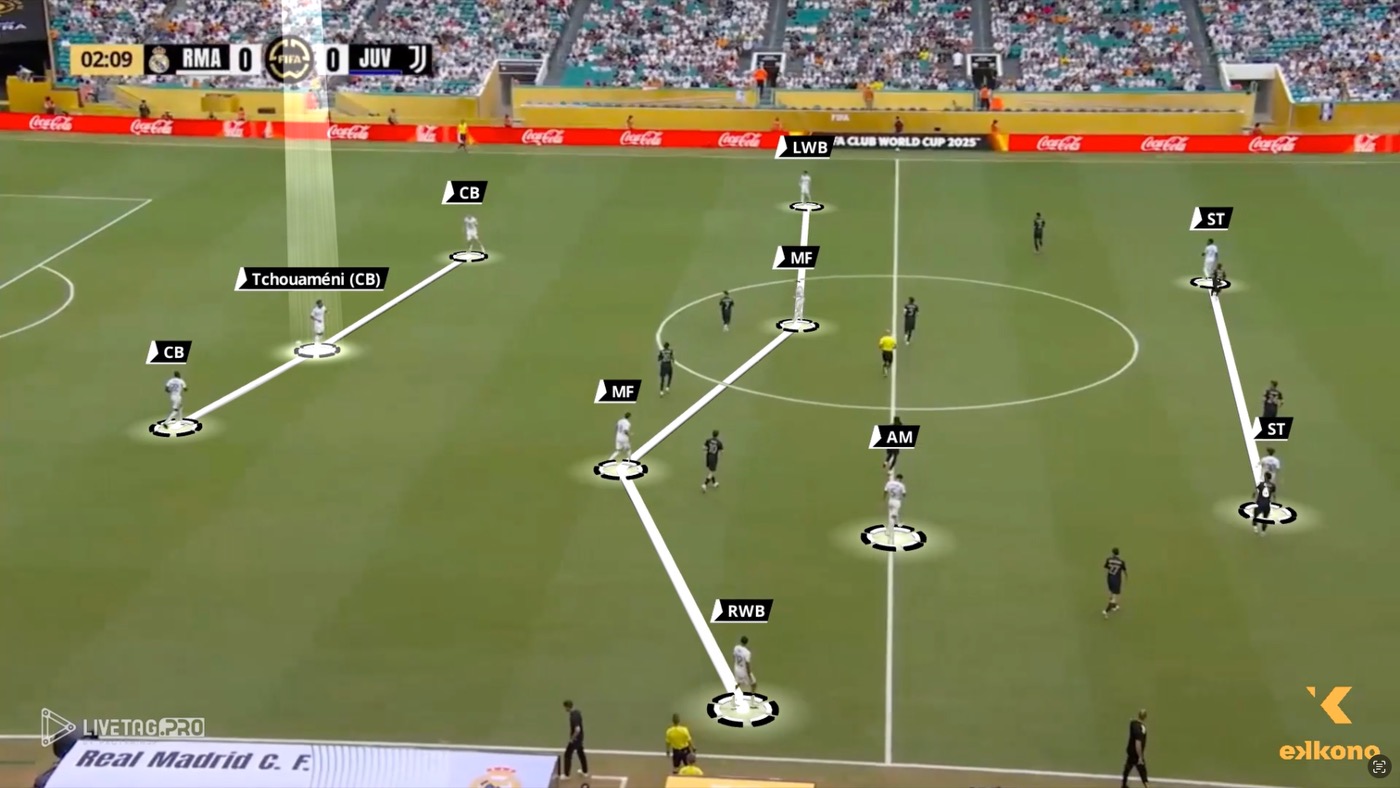
Tchouaméni as Structural Base and Third Center Back 2
Tchouaméni plays a hybrid role, alternating between holding midfielder and center-back depending on the match or even within the same match. In this example, he drops into the back line to form a third center-back during the build-up phase.
Vinícius Reimagined: From Winger to Second Striker
Interiorization and its Effects
Perhaps the most visible evolution has been the repositioning of Vinícius Júnior. Rather than operating as a traditional winger hugging the touchline, Vinícius Jr. now plays as one of the two forwards in the 3-4-1-2. This allows him to occupy the left half-space more often, freeing the wide channel for Fran García’s aggressive overlapping runs. The result is a functional asymmetry, with width maintained on the left by García and alternated on the right by Alexander-Arnold, creating dilemmas for opposing defenses about whether to protect inner lanes or wide depth.
Key Functions of Vinícius
Vinícius’s interior role enhances his influence in several ways. By drifting into central areas, he opens lateral corridors for the wingback (Fran García or Álvaro Carreras), while also becoming a key receiver between the opponent’s lines in advanced zones. From there, he can turn quickly, carry the ball inside, and combine in small triangles with Güler and Valverde, particularly effective against mid-blocks. In transitions, his role has shifted from wide dribbler to direct central runner, attacking the space between center-back and full-back with diagonal runs, often released by Güler’s vertical passes. This evolution makes his speed and unpredictability more dangerous in valuable central spaces.
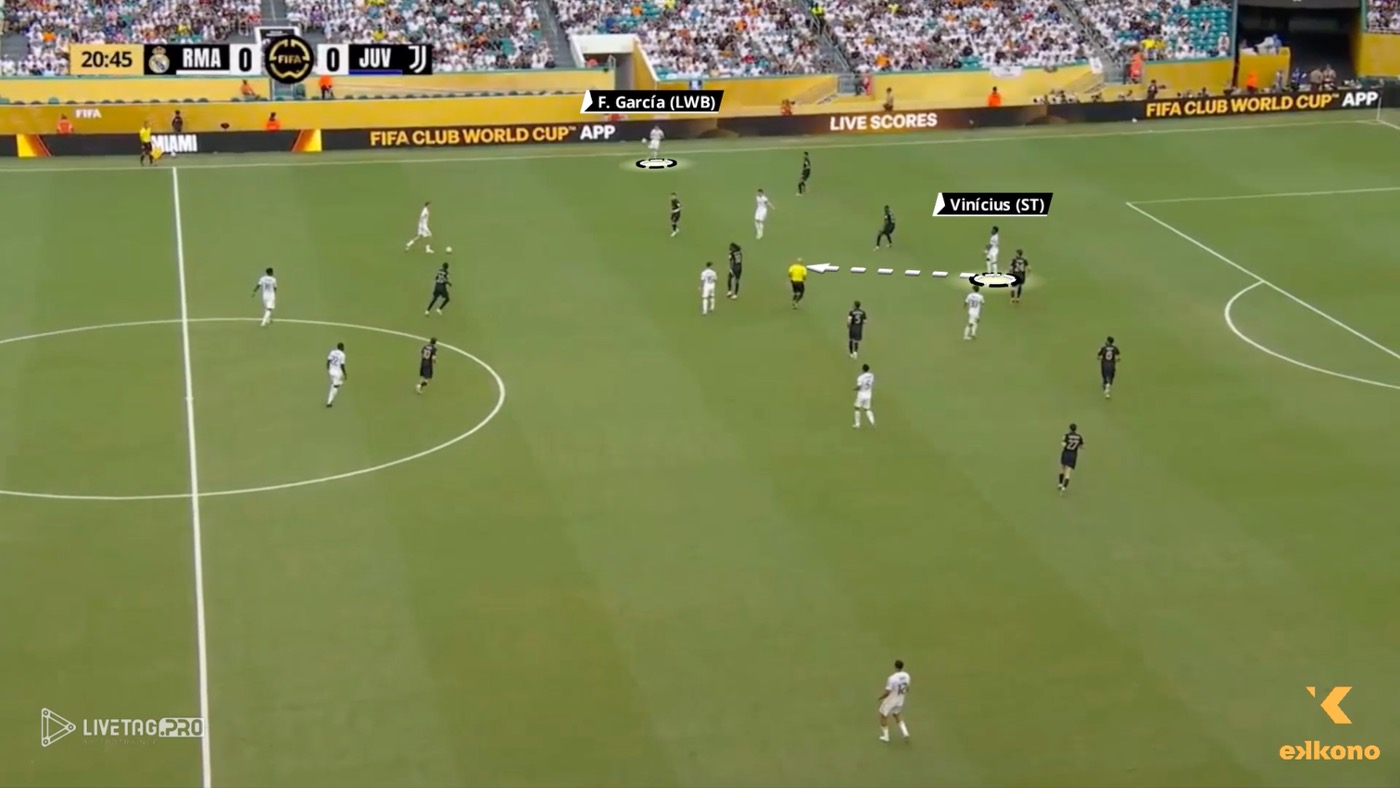
Vinícius. Interiorization and its Effects 1
Fran García (LWB) is usually the player who provides width on the left flank, allowing Vinícius (ST) to move inside, either to receive in the pockets or attack the space.
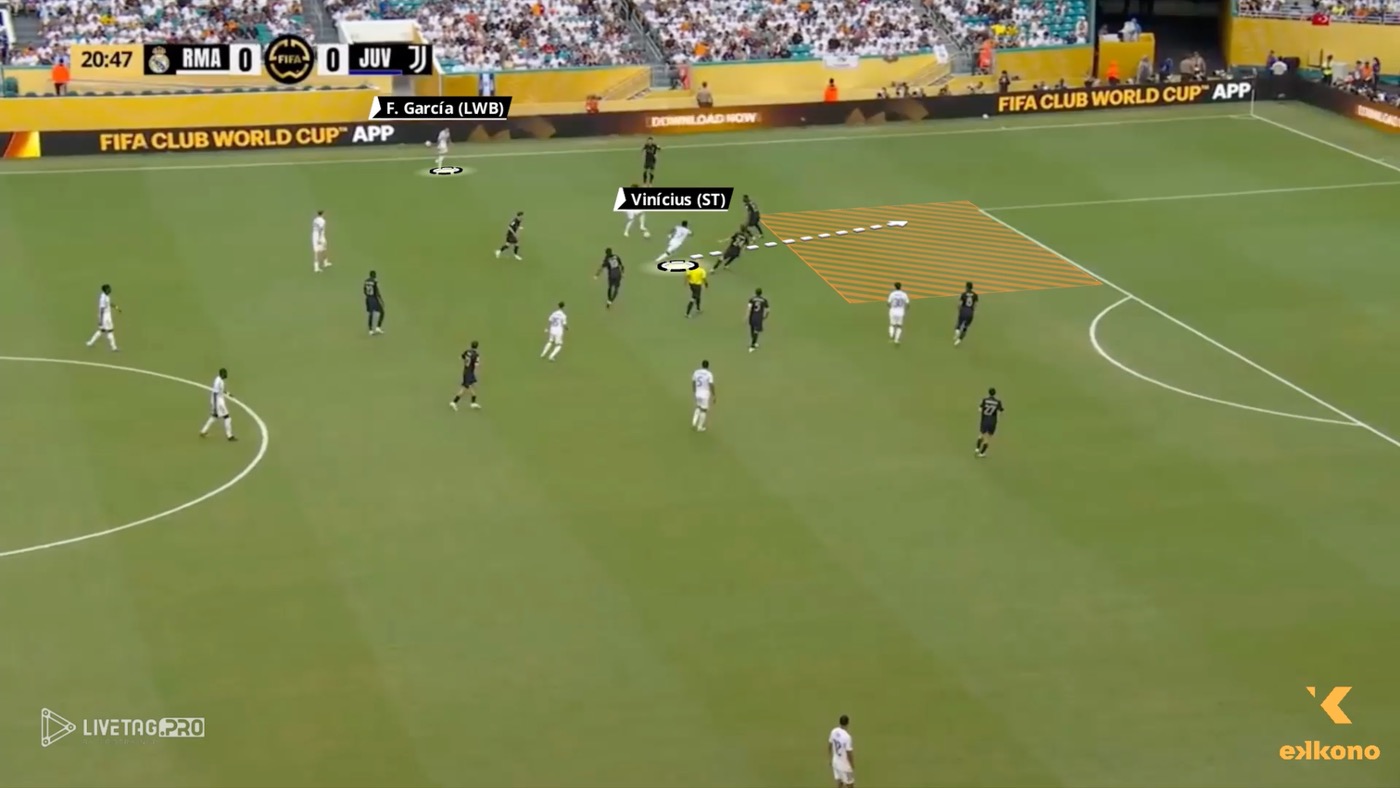
Vinícius. Interiorization and its Effects 2
In this example, Vinícius (ST) combines with Valverde (MF) in a one-two and attacks the space behind the center-back.
Relationship with Fran García
This reconfiguration directly benefits Fran García, who now consistently finds himself in advanced and isolated wide positions. With Vinícius occupying the interior lanes, the left wing-back can progress unimpeded along the flank, using long carries and engaging in one-on-one situations before delivering crosses or attacking the byline. Meanwhile, Vinícius arrives in central finishing positions, complementing Fran’s width.
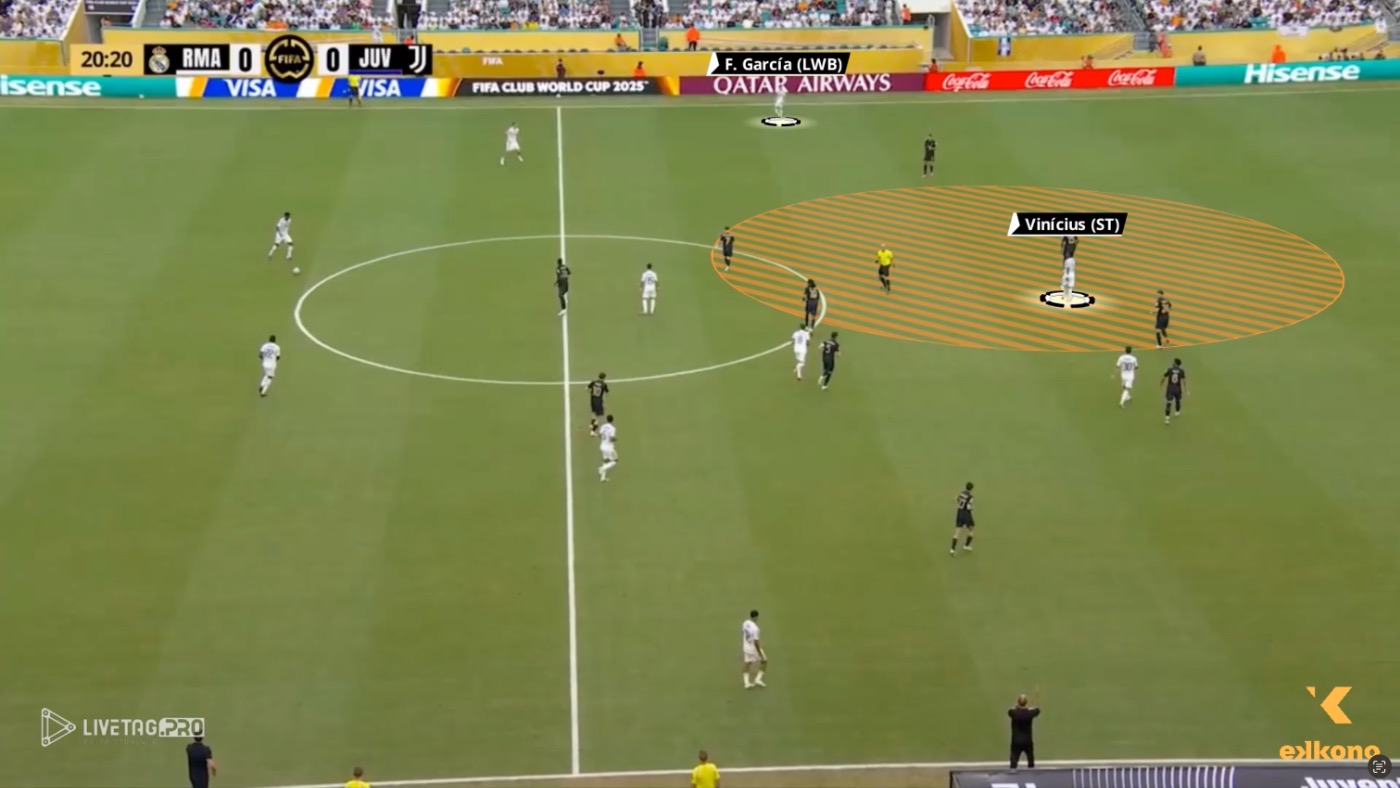
Vinícius. Relationship with Fran García 1
Once again, we see Vinícius occupying the central corridor, drawing attention and creating a gap between the opposing center-back and full-back.
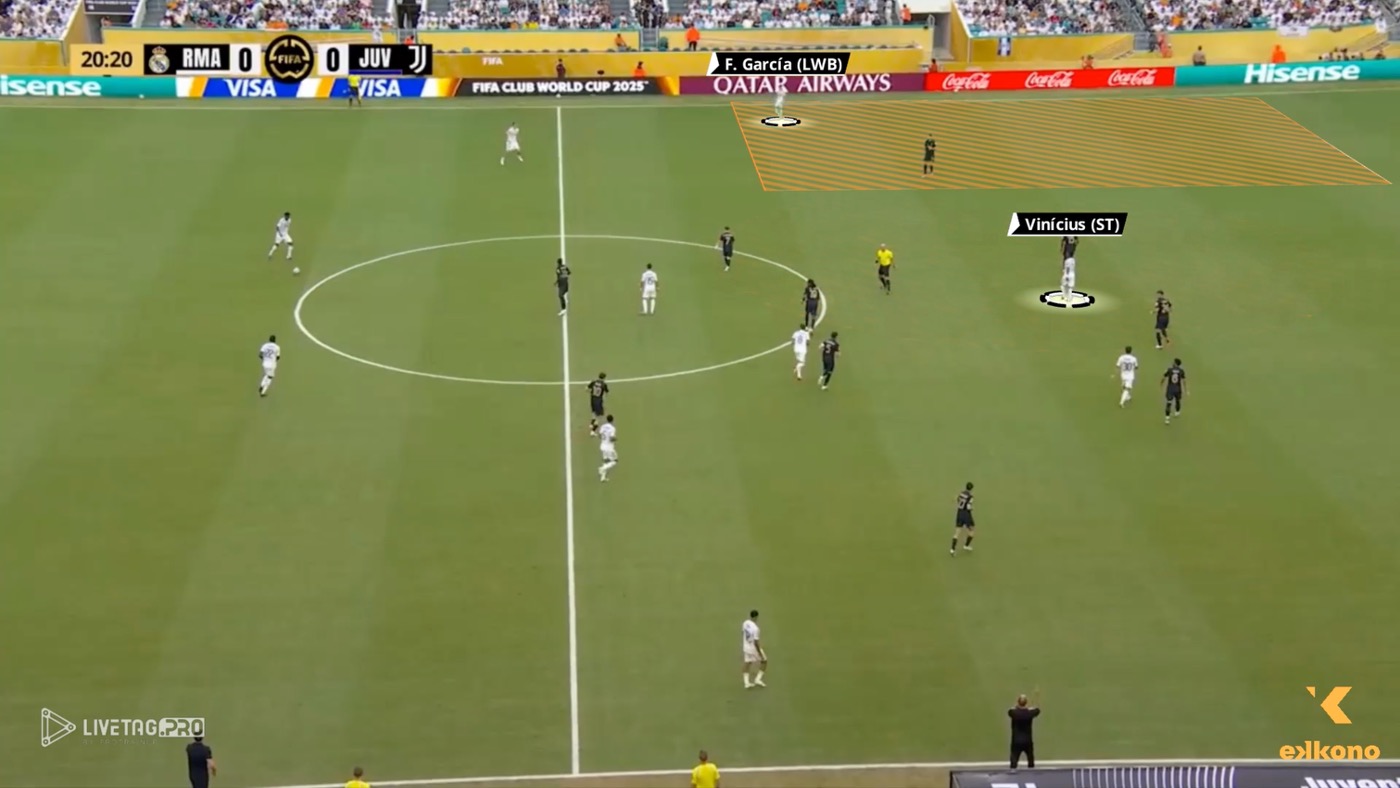
Vinícius. Relationship with Fran García 2
Vinícius’s (ST) positioning allows Fran García (LWB) to receive in a 1v1 situation and also opens space for teammates to attack the gap.
Defensive Phases and Pressing Structures
High Hybrid Pressing: 3-1-4-2 / 4-1-3-2
Defensively, Real Madrid employs a hybrid high press that blends zonal and situational individual markings. The objective is to guide the opponent’s play wide, trap the opponent in a quadrant, and cause errors rather than applying relentless individual pressure. The forwards direct play to the flanks, Bellingham steps up to cover the holding midfielder or ball-carrying center-back, and the fullbacks or wingbacks press when coverage is secure. Güler and Valverde remain vigilant in the center, protecting diagonal passing lanes. Tchouaméni shows flexibility here as well, stepping up when play develops centrally but maintaining a covering role as a third center back when the ball is wide.
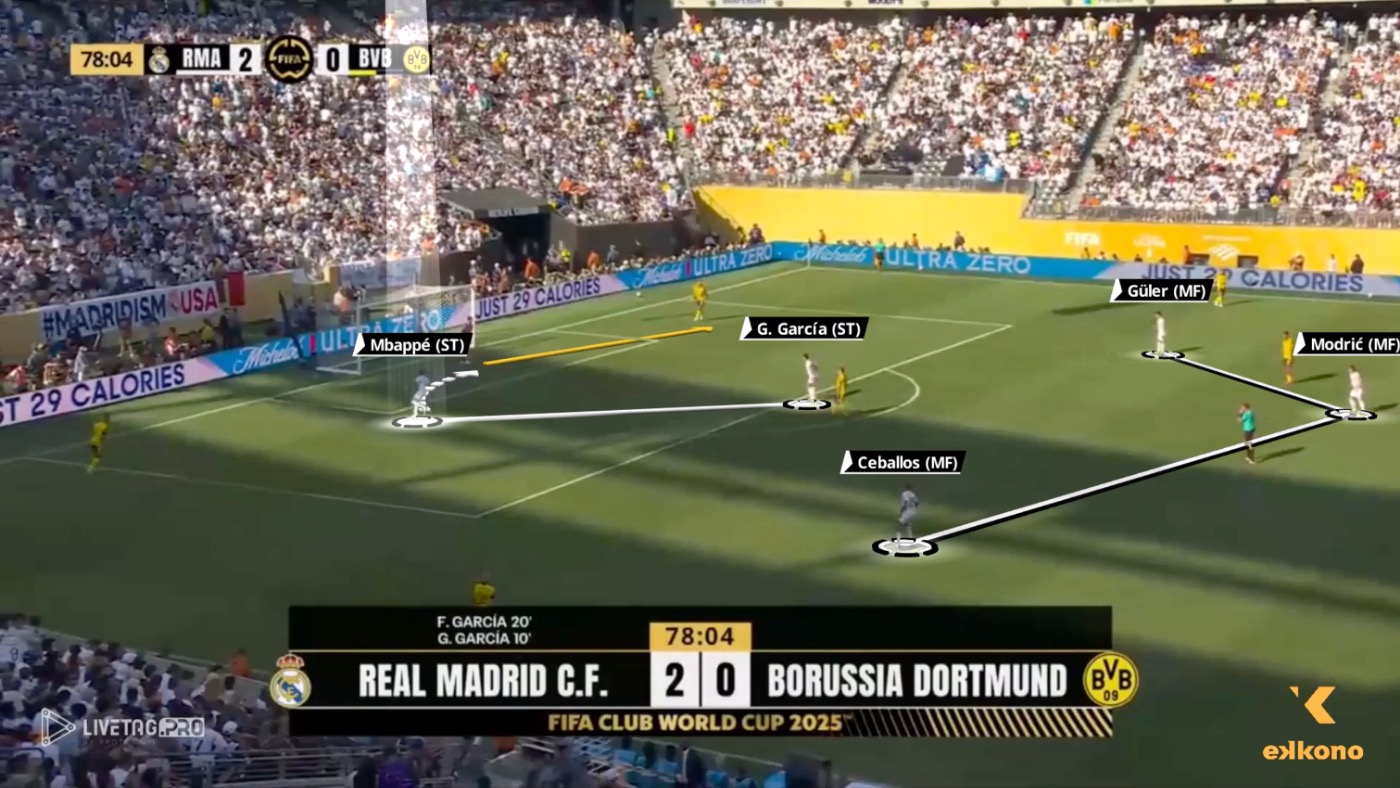
Real Madrid. High Hybrid Pressing: 3-1-4-2 / 4-1-3-2 (1)
In this sequence, Mbappé (ST) closes the passing lane, forcing the goalkeeper to play to the left and preventing the return pass.
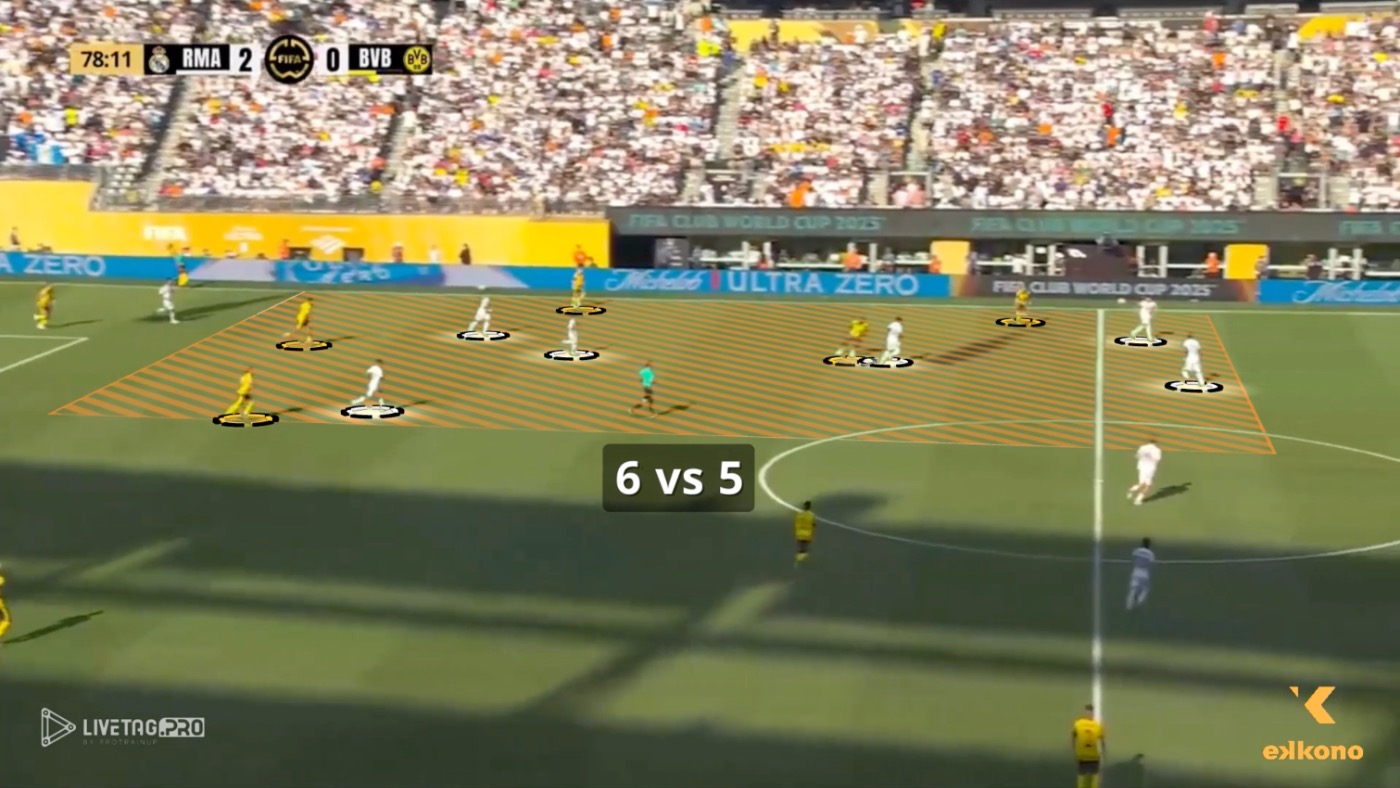
Real Madrid. High Hybrid Pressing: 3-1-4-2 / 4-1-3-2 (2)
The sequence ends with Borussia Dortmund forced to play long, while Real Madrid maintains a 6-vs-5 numerical advantage in the zone around the ball.
Mid/Low Block: Compact 5-3-2
When the initial press is bypassed, the team transitions into an organized and compact 5-3-2, designed to deny central spaces, protect the edge of the box, and force the opponent to play ineffective wide balls. Tchouaméni acts as an aggressive sweeper, correcting in wide areas or following interior runs. Güler anchors the midfield centrally, prioritizing to cut passing lanes without tracking players too aggressively, while the wingbacks adjust their height to maintain balance and be ready to step up if necessary.
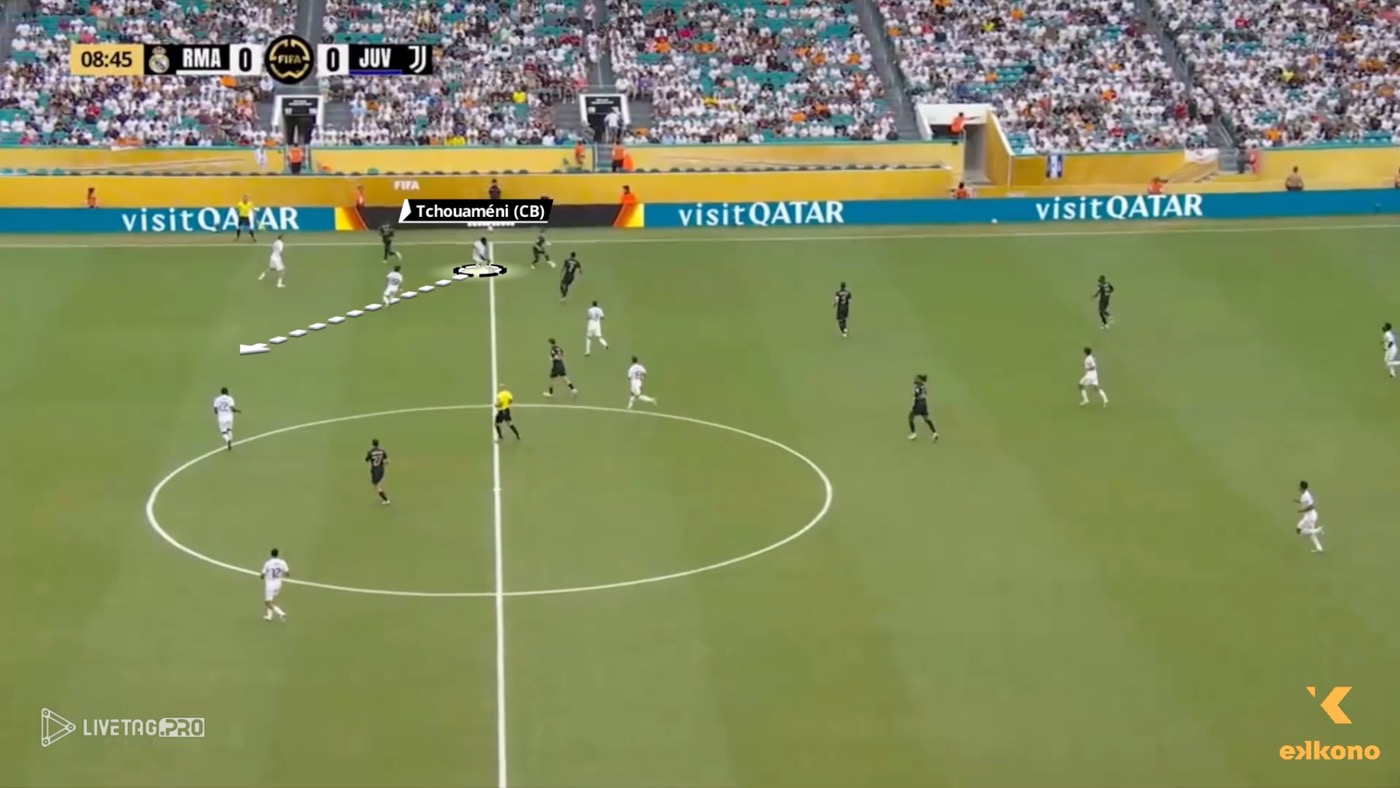
Real Madrid. Mid/Low Block: Compact 5-3-2 (1)
After losing possession, Tchouaméni (HM) drops between the two center-backs to reestablish a back five.
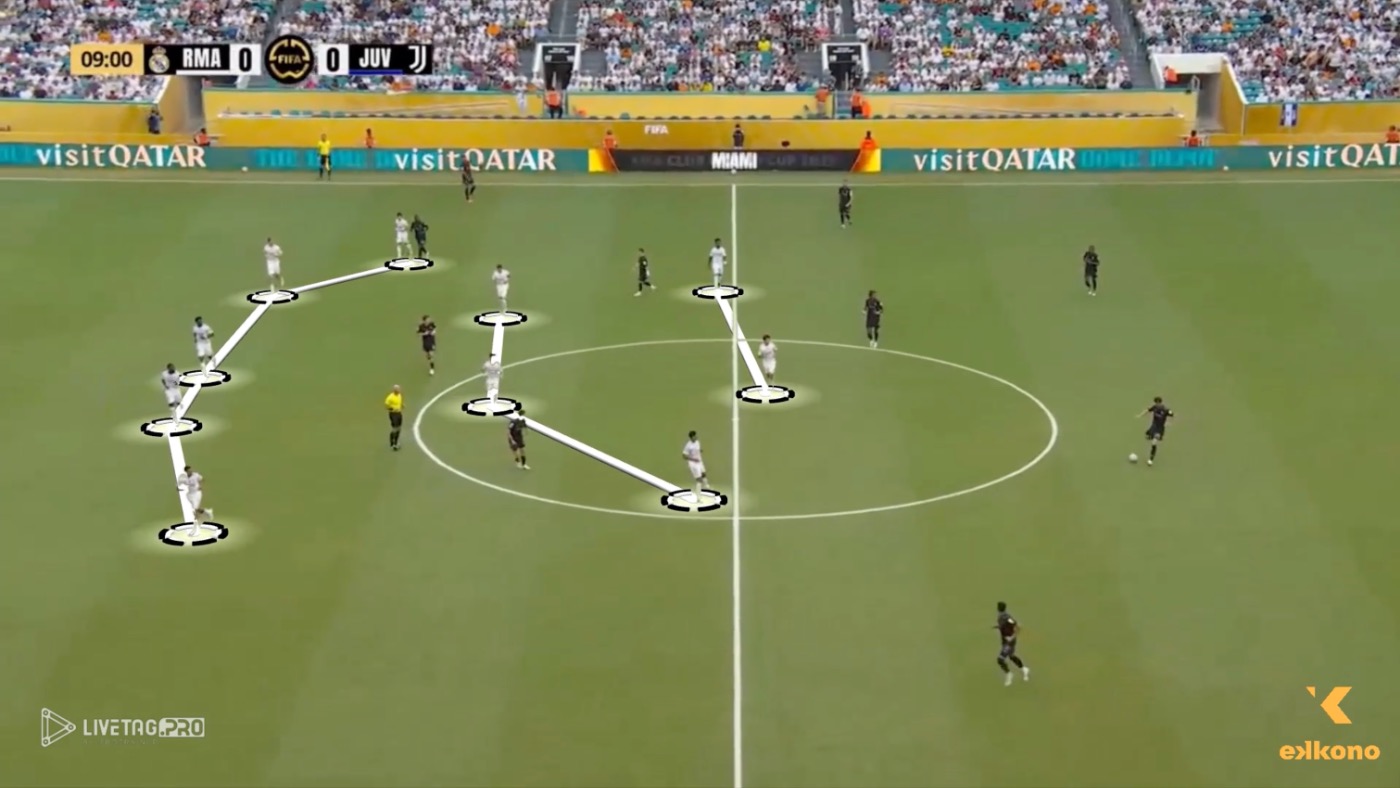
Real Madrid. Mid/Low Block: Compact 5-3-2 (2)
In mid-block and low-block phases, Real Madrid defends in a 5-3-2 structure, with Tchouaméni dropping into the back line as a center-back and Vinícius and Mbappé positioned as strikers.
Valverde as Right Wingback
One of the more intriguing defensive variations sees Federico Valverde deployed as a right wingback, particularly useful against opponents with dangerous wide players. This role, though, might change when Dani Carvajal is back to his 100% after his knee injury last season. Valverde’s dynamism bolsters Madrid’s ability to defend long switches of play and enhances transition play after recoveries, as his presence allows Tchouaméni greater freedom to step up and anticipate.
Main Challenge: Integrating Mbappé and Vinícius
The experiment of fielding both Kylian Mbappé and Vinícius as strikers revealed certain weaknesses in the first matches. The pressing structure became less coordinated and intense, with a noticeable disconnect between the front and midfield lines. Bellingham was often isolated, and Güler was exposed without Tchouaméni advancing. Both star forwards seemed reluctant to fully engage in the defensive responsibilities required, highlighting the need for Alonso to find a balance between their offensive freedom and the collective pressing mechanisms.
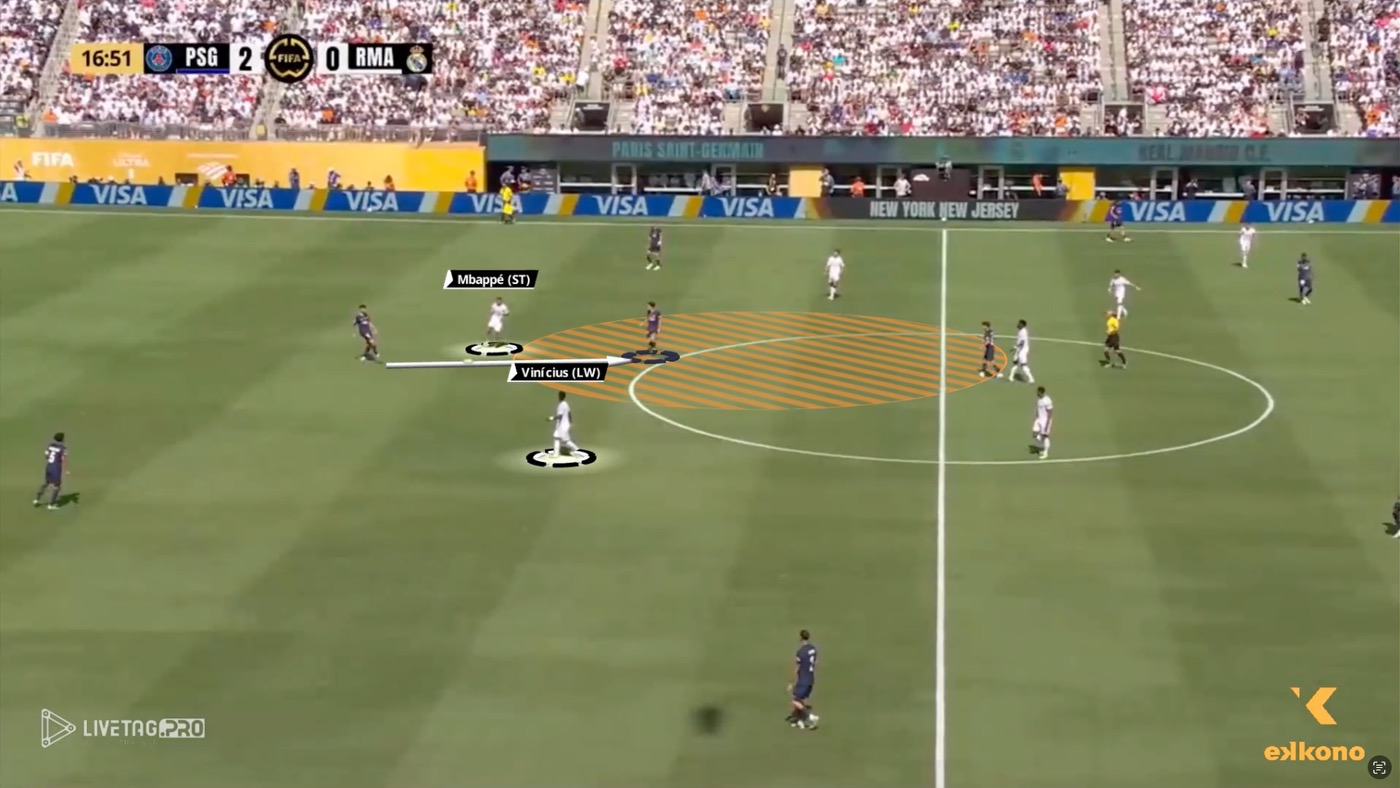
Mbappé passiv pressing 1
One of Xabi Alonso’s main challenges is engaging his forwards more actively in the defensive phase. In this sequence, we see Mbappé (ST) pressing passively and failing to close the passing lane to Vitinha (CM).
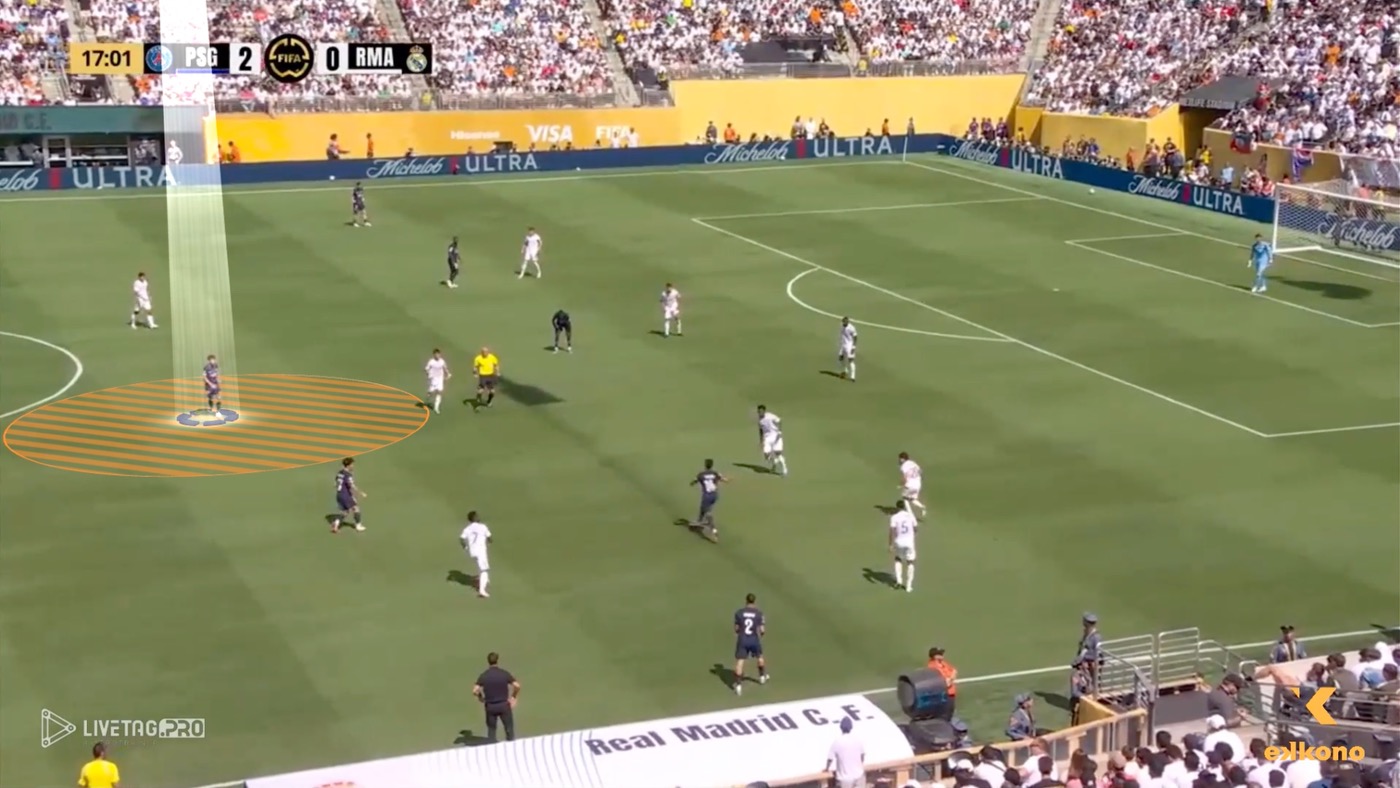
Mbappé passiv pressing 2
With Mbappé not tracking back to help maintain a compact defensive block, PSG is able to switch play and change the point of attack with ease.
Alonso at Real Madrid: The Road Ahead
Xabi Alonso’s Real Madrid already displays the outlines of a distinctive tactical identity reminiscent of his work at Bayer Leverkusen, though still in its early stages. Positive signs are evident, particularly in the redefined roles of key players, but many aspects still need to evolve and mature. The greatest challenge ahead will be integrating all these exceptional talents into a coherent, balanced system without compromising the core principles of his game model. The process is underway, but the definitive shape of this project is yet to emerge — and how Alonso steers this evolution will likely define his tenure at Los Blancos.

